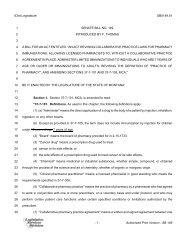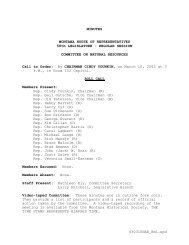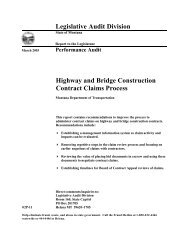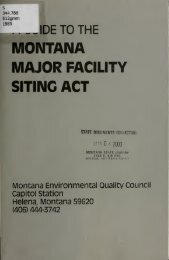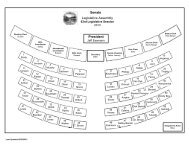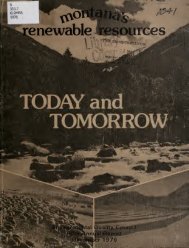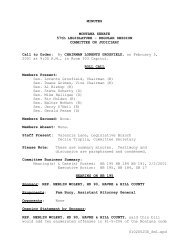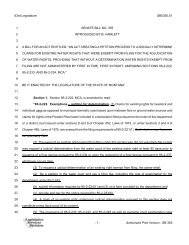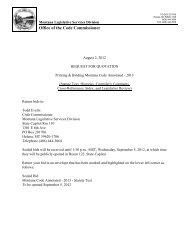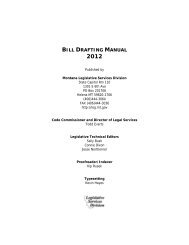Public Comment. Volume III - Montana Legislature
Public Comment. Volume III - Montana Legislature
Public Comment. Volume III - Montana Legislature
You also want an ePaper? Increase the reach of your titles
YUMPU automatically turns print PDFs into web optimized ePapers that Google loves.
DRAFT, 4/9/85<br />
9 0 AQUATIC ECOLOGY IMPACT MIT1GAT:ION -- .<br />
9.1 General<br />
Impacts to acquatic resources from the proposed Tongue River<br />
Railroad are likely to occur only in those areas where the<br />
railroad grade directly infringes upon the stream bank or stream<br />
bed. Such places include river crossings requiring bridge<br />
construction and areas where rip-rap is required for stream bank<br />
stabilization. In coordination with state agencies, primarily<br />
the Department of Fish, Wildlife, and Parks, the Applicant should<br />
proceed with detailed, site-specif ic inventory work of potential<br />
impact sites, upon the completion of third phase engineering.<br />
Based upon the results of the work, specific mitigative measures<br />
can be determined and applied.<br />
(1) . Aquatic Resource Samplinq, For those locations where<br />
the proposed Tongue River Railroad would cross the<br />
~ongue kiver , or- where extensive rip-rapping would<br />
occur, a three-part plan of study shou3.d be undertaken<br />
to identify aquatic resources. The results of the<br />
study would be utilized in the development of mitigation<br />
plans. The three-part plan of study includes: (a)<br />
a stream habitat survey to identify existing habitat<br />
features and values; (b) benthic macroinvertebrate<br />
sampling to identify community composition and numbers;<br />
and (c) fish spawning survey to determine the importance<br />
of the area to spawning of game fish.<br />
a. Stream Habitat Survey. The stream habitat survey<br />
should utilize methods described in "Methods for<br />
valuating Stream, Riparian, and Biotic Conditions.<br />
n2 Stream transects would be established in<br />
appropriate locations to evaluate existing conditions<br />
and to monitor changes during construction.<br />
. Along each transect, the following variables would<br />
be measured:<br />
1. stream width<br />
2. stream shore depth<br />
3. stream average depth<br />
4. pool (ft.)<br />
2~illiam S. Platts, Walter F. Megahan, and G. Wayne Minshall,<br />
mMethods for Evaluating Stream, Riparian, and Biotic Conditions,"<br />
General Technical Report Int-138, Intermountain Forest Range and<br />
Research Experiment Station, Ogden, Utah.<br />
EQC Eminent Domain Study -207-



